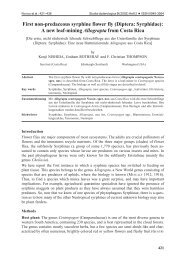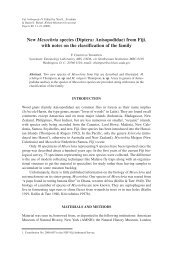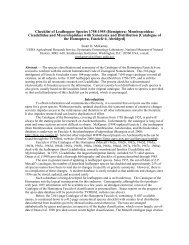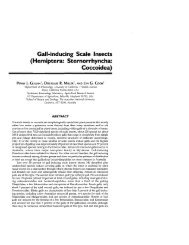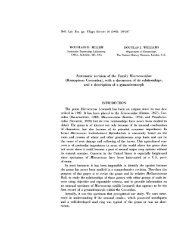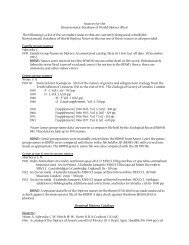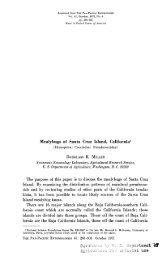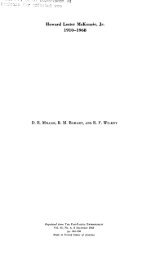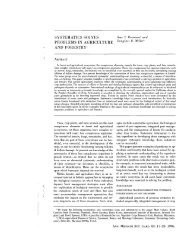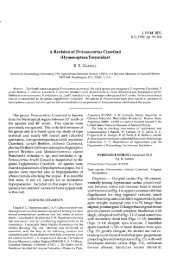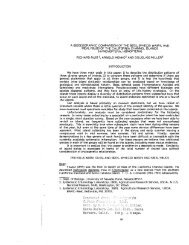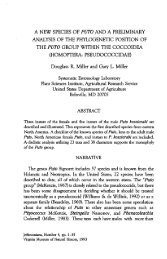Fruit Fly Expert Identification System and Systematic Information
Fruit Fly Expert Identification System and Systematic Information
Fruit Fly Expert Identification System and Systematic Information
Create successful ePaper yourself
Turn your PDF publications into a flip-book with our unique Google optimized e-Paper software.
Norrbom Status of Knowledge 31<br />
Table 6. Number of species of Tephritidae for which some immature stages have been described.<br />
Adults Immatures<br />
Region Genera Species Genera (%) Species (%)<br />
Afrotropical 151 920 20 (13.2) 35 (3.8)<br />
Australasian 144 762 3 (2.1) 20 (2.6)<br />
Nearctic 60 358 30 (50.0) 80 (22.3)<br />
Neotropical 68 717 9 (13.2) 31 (4.3)<br />
Oriental 155 943 4 (2.6) 12 (1.3)<br />
Palearctic 126 827 39 (31.0) 109 (13.2)<br />
World 471 4,257 91 (19.3) 291 (6.8)<br />
Numbers for immatures based on 1992 data<br />
some species of Tephritinae. The anterior spiracles are sessile<br />
or nearly so, <strong>and</strong> usually fan-shaped or bimodal, with 2-53<br />
papillae (Ferrar 1987). The cephalopharyngeal skeletons of all<br />
species so far described are typically muscomorph, with right<br />
<strong>and</strong> left m<strong>and</strong>ibles equally developed, <strong>and</strong> sometimes with 1-2<br />
subapical teeth persisting into the third instar (as far as known,<br />
subapical teeth are always well-developed in earlier instars).<br />
<strong>Fruit</strong> fly puparia are usually barrel-shaped, but rarely are beanshaped<br />
or have a flattened caudal segment. They may be smooth<br />
or wrinkled, with distinct or unclear segmentation. They range<br />
in color from white to yellow, brown or black, <strong>and</strong> their color<br />
may vary from the anterior to the posterior end.<br />
Morphology & Terminology<br />
McAlpine (1981) proposed a morphological terminology<br />
for adult Diptera that is st<strong>and</strong>ardized with that of other insects<br />
<strong>and</strong> is well illustrated. Proposed modifications to this terminology<br />
or more specific applications of it to the Tephritidae include<br />
Steyskal (1984), Norrbom & Kim (1988[3666]), Freidberg &<br />
Mathis (1986), White (1988), White & Elson-Harris (1992) <strong>and</strong><br />
Foote et al. (1993). White & Elson-Harris (1992) provided an<br />
extensive glossary. Extensive discussions <strong>and</strong>/or illustrations<br />
of morphological terminology were also included by Hendel<br />
(1927[2109]; Hering <strong>and</strong> Ito used this terminology), Shiraki<br />
(1933), Munro (1947, 1984), Foote (1980), Freidberg &<br />
Kugler (1989), Kapoor (1993; includes most terms used by<br />
Hardy) <strong>and</strong> Merz (1994[3343]). Some additional useful references<br />
on tephritid adult morphology include: general -Aczél<br />
(1955[28], May (1963[3232]), Zaka-ur-Rab (1971), Valdez-<br />
Carrasco & Prado-Beltran (1991); digestive system - Dean<br />
(1933), Kobayashi (1934), Zaka-ur-Rab (1971); antenna -<br />
Giannakakis & Fletcher (1985), Vasey & Ritter (1987), Dickens<br />
et al. (1988), Bigiani et al. (1989), Crnjar et al. (1989, 1989),<br />
Mayo et al. (1987); compound eye - Agee et al. (1977), Davis<br />
et al. (1983); head -Nayar (1961[3567]); integument - Evans<br />
(1967[1358]); mouthparts - Driscoll & Condon (1994); musculature<br />
<strong>and</strong> internal anatomy - Zaka-ur-Rab (1971), Berube &<br />
Zacharuk (1983[429]), Valdez-Carrasco & Prado-Beltran<br />
(1991); nervous system -Kobayashi (1934), Zaka-ur-Rab<br />
(1971); reproductive systems <strong>and</strong> genitalia -Kobayashi (1934),<br />
Dean (1935), Hanna (1938), Drew (1969), Zaka-ur-Rab (1971),<br />
Dodson (1978[1193]), Korneyev (1979, 1985[2715]),<br />
Zacharuk et al. (1986), Stoffolano & Yin (1987), Norrbom &<br />
Kim (1988[3666]), Williamson (1989), Eberhard & Pereira<br />
(1993), De Carlo et al. (1994); <strong>and</strong> thorax - Nayar (1962),<br />
Verma (1985).<br />
Freidberg & Kugler (1989) defined various types of tephritid<br />
wing patterns, <strong>and</strong> terminologies for the parts of various<br />
b<strong>and</strong>ed patterns were proposed by Lima (1934[2954]) <strong>and</strong><br />
Stone (1942[4674]) for Anastrepha, Bush (1966[683]),<br />
Steyskal (1979), Foote (1981), <strong>and</strong> Freidberg & Hancock<br />
(1989) for Rhagoletis, Cryptophorellia <strong>and</strong> Urophora, which<br />
are similar in wing pattern, Munro (1984) for the Dacina,<br />
Freidberg (1991) for Ceratitis, <strong>and</strong> Freidberg & Kaplan (1992)<br />
for the Oedaspidina. White & Elson-Harris (1992) used st<strong>and</strong>ardized<br />
terms for similar b<strong>and</strong>s in several economic genera.<br />
Terminology for the larvae of Diptera was recently reviewed<br />
by Teskey (1981, 1991), <strong>and</strong> White & Elson-Harris<br />
(1992) provided an extensive glossary of morphological terms<br />
for larval Tephritidae. Phillips (1946) summarized previous<br />
terminologies for the cephalopharyngeal skeleton <strong>and</strong> presented<br />
a terminology for the caudal segment. Carroll & Wharton<br />
(1989) proposed a terminology for specific sensilla.<br />
Terminology for sense organs of the head is confusing; four<br />
different systems have been used in the Tephritidae. That of<br />
Teskey (1981), following Weismann (1864), has been the most<br />
common <strong>and</strong> was used by Efflatoun (1927), K<strong>and</strong>ybina (1977),<br />
Steck & Wharton (1986, 1988), Steck & Malavasi (1988),<br />
Carroll & Wharton (1989), Carroll (1992) <strong>and</strong> White & Elson-<br />
Harris (1992). The other terminologies include: Snodgrass<br />
(1924), used by Phillips (1946) <strong>and</strong> Exley (1955); Bolwig<br />
(1946), used by Headrick, Goeden <strong>and</strong> coauthors (e.g., Goeden<br />
& Headrick (1990)); <strong>and</strong> Snodgrass (1953), used by Novak &<br />
Foote (1968, 1975, 1980) <strong>and</strong> Steck (1984).<br />
Detailed, comprehensive anatomical studies of tephritid<br />
larvae include Snodgrass (1924), Knell & Stoffolano (1973),<br />
Zaka-ur-Rab (1978[5283], 1978[5284], cephalopharyngeal<br />
musculature, tracheal system), Dean (1932, alimentary canal,<br />
1942, reproductive system), Bates (1934[351], peristigmal<br />
gl<strong>and</strong> cells), <strong>and</strong> Butt (1937) <strong>and</strong> Jones & Kim (1988) (posterior<br />
stigmatic apparatus).<br />
Taxonomic Knowledge of Immature Stages<br />
In spite of the economic importance of Tephritidae, the<br />
immature stages (eggs, larvae, puparia) are poorly known. The<br />
figures in the classification table are overestimated, as many of



